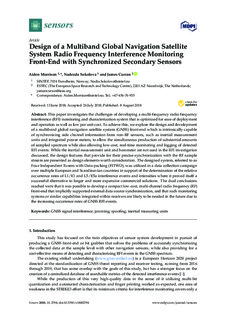| dc.contributor.author | Morrison, Aiden J | |
| dc.contributor.author | Sokolova, Nadezda | |
| dc.contributor.author | Curran, James | |
| dc.date.accessioned | 2018-08-24T09:36:25Z | |
| dc.date.available | 2018-08-24T09:36:25Z | |
| dc.date.created | 2018-08-13T14:42:16Z | |
| dc.date.issued | 2018 | |
| dc.identifier.citation | Sensors, 2018, 18 (8), 15 | nb_NO |
| dc.identifier.issn | 1424-8220 | |
| dc.identifier.uri | http://hdl.handle.net/11250/2559203 | |
| dc.description.abstract | This paper investigates the challenges of developing a multi-frequency radio frequency interference (RFI) monitoring and characterization system that is optimized for ease of deployment and operation as well as low per unit cost. To achieve this, we explore the design and development of a multiband global navigation satellite system (GNSS) front-end which is intrinsically capable of synchronizing side channel information from non-RF sensors, such as inertial measurement units and integrated power meters, to allow the simultaneous production of substantial amounts of sampled spectrum while also allowing low-cost, real-time monitoring and logging of detected RFI events. While the inertial measurement unit and barometer are not used in the RFI investigation discussed, the design features that provide for their precise synchronization with the RF sample stream are presented as design elements worth consideration. The designed system, referred to as Four Independent Tuners with Data-packing (FITWD), was utilized in a data collection campaign over multiple European and Scandinavian countries in support of the determination of the relative occurrence rates of L1/E1 and L5/E5a interference events and intensities where it proved itself a successful alternative to larger and more expensive commercial solutions. The dual conclusions reached were that it was possible to develop a compact low-cost, multi-channel radio frequency (RF) front-end that implicitly supported external data source synchronization, and that such monitoring systems or similar capabilities integrated within receivers are likely to be needed in the future due to the increasing occurrence rates of GNSS RFI events | nb_NO |
| dc.language.iso | eng | nb_NO |
| dc.relation.uri | http://www.mdpi.com/1424-8220/18/8/2594 | |
| dc.rights | Navngivelse 4.0 Internasjonal | * |
| dc.rights.uri | http://creativecommons.org/licenses/by/4.0/deed.no | * |
| dc.subject | GNSS | nb_NO |
| dc.title | Design of a Multiband Global Navigation Satellite System Radio Frequency Interference Monitoring Front-End with Synchronized Secondary Sensors | nb_NO |
| dc.type | Journal article | nb_NO |
| dc.type | Peer reviewed | nb_NO |
| dc.description.version | publishedVersion | nb_NO |
| dc.subject.nsi | VDP::Informasjons- og kommunikasjonsvitenskap: 420 | nb_NO |
| dc.subject.nsi | VDP::Information and communication science: 420 | nb_NO |
| dc.source.pagenumber | 15 | nb_NO |
| dc.source.volume | 18 | nb_NO |
| dc.source.journal | Sensors | nb_NO |
| dc.source.issue | 8 | nb_NO |
| dc.identifier.doi | 10.3390/s18082594 | |
| dc.identifier.cristin | 1601591 | |
| cristin.unitcode | 7401,90,0,0 | |
| cristin.unitname | SINTEF IKT | |
| cristin.ispublished | true | |
| cristin.fulltext | original | |
| cristin.qualitycode | 1 | |

